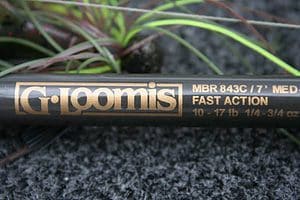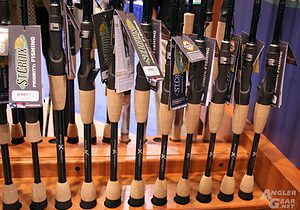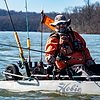Disclosure: Some posts contain affiliate links, which earn us a commission if you make a purchase through them. Positive Fishing © participates in various affiliate networks including the Amazon Services LLC Associates Program.
Purchasing the ideal fly rod isn’t as simple and straightforward as many would like. Identifying the proper action and weight for your type of fishing and skill level takes time. Dozens of factors go into the decision-making process that can easily overwhelm someone who isn’t quite sure what’s necessary. Thankfully, companies are now starting to manufacture rods with more versatility in their options.
Stay patient with the process; you’ll find a great deal and a rod that fits your preferred style.
Key Takeaways
- Understanding rod weight and action is essential for fly fishing success.
- The right fly rod should match the angler’s skill level and intended fishing technique.
- The fly fishing industry offers diverse rod options tailored to specific fishing scenarios.
Choosing The Right Fly Rod Weight
When you begin your research, you’ll see that fly rods have quite a few numbers listed with them. The numbers always tell you the fly rod’s weight and length. The lower the numbers, the lighter the rod.
For example, a 1 or 2-weight fly rod will be best used in small mountain streams or ponds. They don’t have the power or the strength to fight large fish or make longer casts. However, you make up for what you lose in power in the rod’s ability to thrive in tight situations. Short casts, quick mends, and response time will help you land fish.
A 3- or 4-weight fly rod is nice for smaller streams and rivers. These rods have a bit more backbone and make longer casts. Whether you’re fighting the weather or a 15-inch trout, your 3 or 4-weight should be able to handle it just fine. These rods are great to cast and a favorite weight for many anglers looking to head into the backcountry in pursuit of wild fish.
A 5 or 6-weight fly rod will be home in a large western river or lake throughout the Midwest. Whether you’re targeting large trout or bass, a 5 or 6-weight will work great. Most anglers consider these two weights to be the most versatile. They will come through if you strike into a large fish but still allow you to make those short finesse casts if you find yourself in skinny water.
7-weight up to 11-weight fly rods are meant for large freshwater and saltwater fish. They’re beefy and give anglers massive power to make long casts and test their fishing abilities. If you’re pursuing salmon or saltwater species, you’ll want at least a 7-weight rod.
You must know the type of fish you’re pursuing before purchasing, as a saltwater fly rod and a trout fly rod differ quite considerably.

Choosing The Right Fly Rod Action
The next step in purchasing your fly rod is deciding what action works best for you. With fly rods, you really only have four options! Some spinning rod companies provide their customers with more, but fly rods have less variety.
Slow Action Rod
A slow-action rod is definitely the rarest action anglers use. It’s a more traditional action similar to that of many of the original “old school” fly rods. If you spend the majority of your time on small mountain streams chasing wild trout, a slow-action rod is a solid option. You’ll find that these rods are extremely flexible and will slow everything down for you.
If you’re a beginner, the slower the action, the easier it will be for you to learn. However, the obvious downside with a slow-action rod is that you’re limited in how far you can cast. Also, any inclement weather will make using these rods a challenge. If it’s windy at all, you’ll find yourself fairly frustrated.
You can throw dries, nymphs, and smaller streamers. However, casting large streamers will require considerable effort.
Moderate Action Rod
A moderate-action rod is extremely versatile! It has more backbone than a slow-action rod but is less forgiving than a moderate-fast or fast-action rod. This rod will only bend for half its length. You can fish various flies and water conditions with a moderate-action rod. A moderate-action rod is ideal for a beginner!
Moderate-Fast Action Rod
Moderate-fast action rods are a step up from moderate action in various ways. Moderate action rods can be more versatile, but moderate-fast action rods combine versatility with performance. It still has a nice amount of flex but can perform well depending on the type of fishing you’re doing.
With a moderate-fast action rod, streamers, dries, and nymphs are all fair game. Even if the weather isn’t ideal, you won’t have much trouble with using a moderate-fast action option.
Fast Action Rod
Fast-action rods are powerful and a favorite of more advanced anglers. If you can nail the timing, fast-action rods provide the furthest casts and the most power when fighting a fish. However, you’ll find that it’s not an ideal action for beginners! These rods are best for experts targeting those considerably larger-sized bass and saltwater inshore fly fishing on the flats.
Fly Rod Action Comparison
| Flex Type | Casting Feel | Wind Handling | Ideal For | Fly Line Control |
|---|---|---|---|---|
| Slow Action | Forgiving, slow | Poor | Small streams, trout | Good |
| Medium Action | Medium | Moderate | Versatile environments | Better |
| Moderate Fast Action | Moderate-Fast | Good | Variety of flies | Great |
| Fast Action | Powerful, Fast | Excellent | Long casts, big fish | Best |
What Action and Weight Are Best For Me?

Most people get frustrated when the answer to a question is “It depends.” Regarding the choice of action and weight, however, it truly depends on your skill level and type of fishing! Thankfully, you can narrow down your options fairly quickly.
Beginner Fishing Any Water
If you’re entering the sport and looking for an all-around versatile option that will perform well in most conditions, you’ll want a 5-weight moderate action rod. You’ll have enough weight to fight big fish, but the rod won’t be too overwhelming for some smaller streams. Plus, the moderate action will allow you to learn casting techniques fairly quickly!
Beginner Fishing Small Water
If you’re a beginner and you know you’ll primarily be fishing small water, a 3 or 4-weight fly rod with moderate action will work just fine. You don’t need anything very heavy, and a moderate-action rod will help slow everything down.
When you find yourself on small water, you’ll likely be frustrated with how out of control your rod can feel. The slower things can be, the quicker you’ll learn positive techniques.
Beginner Fishing Large Waters
If you know you’ll be targeting large fish and need something heavier, go with a 6-weight or higher with a moderate-fast action. Moderate-fast action rods take longer to learn, but they’ll allow you to make longer casts and still have the sensitivity to detect some of those lighter strikes.
Intermediate Fishing Any Waters
As you enter the intermediate skill level, a 5-weight moderate-fast action rod would be a great all-around option. Many advanced anglers still use moderate-fast action rods, which aren’t too hard to cast and give you more liberty in your fishing methods.
Intermediate Fishing Small Waters
Fishing primarily in small water isn’t easy! As an intermediate angler, you’ll want a 3 or 4-weight moderate to moderate-fast action. Since it requires so much finesse, you don’t want a rod moving too fast.
Intermediate Fishing Large Waters
Big water can become extremely fun as an intermediate angler! Take along your 6-weight and higher fast action rod. You’ll be able to open up and make some long casts and fight powerful fish. Give your time to practice using this rod on land before you take it to the water.
Advanced Fishing Any Waters
A versatile rod for an advanced angler would be a 5-weight moderate-fast or fast-action rod. You likely already know your preference, but a moderate-fast or fast action should treat you right.
Advanced Fishing Small Waters
Advanced anglers are incredibly picky about their preferences for small water rods! Some prefer traditional slow action, and others prefer fast action! A nice sweet spot is always going to be moderate-fast. However, you still get some versatility with the ability to detect smaller strikes.
Advanced Fishing Large Waters
Fast action all the way! Anything over a 6-weight rod would work well. Fishing for salmon and steelhead can be handled on a 6 to 8-weight rod. Any saltwater or large salmon fishing can be done with a 9 or 10-weight.
Final Thoughts
My experience in fly fishing has shown me that patience and knowledge are your best allies in the quest for the ideal rod. It’s about matching the gear to your specific needs and style. Rod manufacturers offer a variety of weights and actions designed for everything from delicate dry fly presentations to euro nymphing or battling with larger streamer-chasing species.
Rod weight and action can be challenging things to understand and maneuver. However, the more comfortable you get on the water, the more knowledge you’ll gain about your preferences. It may take some trial and error, but that’s the fun of fly fishing!
If this article was helpful, you might be interested in my reading my in-depth article on freshwater spinning rod weight and action.
- Wading Belt Essentials: Ensuring Safer Fishing - January 9, 2024
- Fishing For Catfish (Top Tips, Bait, & Gear To Catch The Big 3) - October 20, 2022
- Fishing Line Strength Vs. Diameter Chart: Why Is It Important? - October 12, 2022

